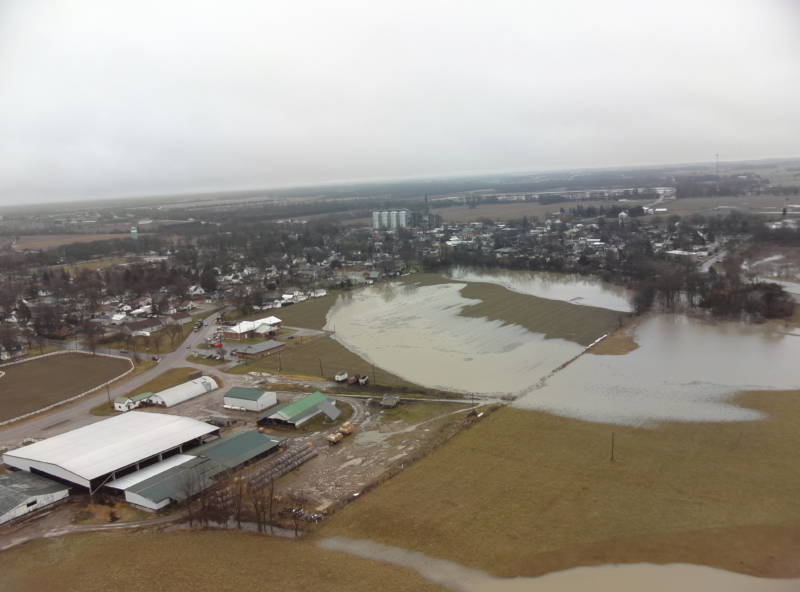
Warm temperatures, melting snow and heavy rainfall over the last week have led to large amounts of flooding in the Thames River watershed.
Lower Thames Valley Conservation Authority officials say a flood warning remains in place in Chatham and Thamesville.
“Pretty much all the snow in the Lower Thames watershed has melted and there is no longer any ice cover on the Thames River,” stated Jason Wintermute, water management supervisor, in a press release issued at 1 a.m. on Saturday.
“Weather forecasts are calling for daytime highs above freezing this weekend with a chance of rainfall anywhere between 5 and 30 mm. Water levels on the Thames River in upstream areas have dropped. On the Lower Thames, water levels through Middlesex and Elgin have also peaked and are now dropping. However, water levels are still high on the Thames River throughout most of the Lower Thames.”
Wintermute says the peak flow would be passing through the Thamesville area overnight or early Saturday morning.
“The high water level is substantially lower and the arrival time of the peak is substantially delayed compared to other events on record for such high flows coming out of the Upper Thames,” Wintermute says.
“While there are homes in the Thamesville area that have been impacted by flooding, there is no longer expected to be flooding on roads in the community of Thamesville.”
Along the Thames River in the City of Chatham, water levels have already exceeded those observed in 2008/2009.
“There is already flooding on those roads previously mentioned; Siskind Court, William and Water, Salter, Pegley, and the low portion of Thames St along the river,” Wintermute says.
“Current forecasts suggest that water levels may still reach as high as those observed during the 1968 flood. This would see an additional 60 cm rise from those levels observed earlier yesterday evening. The peak in Chatham is now expected this evening. However, forecasts may need to be revised as water levels in the city are influenced by levels on Lake St. Clair which are currently high.”
While most of the smaller local watercourse that drain into the Thames River had started to decline, with high flows of the river, water is now backing up these watercourse and may cause flooding in adjacent areas.
“High water levels can be expected throughout the weekend in the Lower Thames and into early next week for areas through Chatham-Kent and Lakeshore,” Wintermute says.
“Residents with properties that back onto watercourses and the river should secure their properties and remove any items that could be damaged by flooding or get loose and become floating debris. Attempts should also be made to ensure that catch basins and other drainage works are free of debris and can function properly.”
Wintermute added: “People should take extra caution and avoid the river, ditches, and streams. The combination of slippery banks, floating debris, and fast moving cold water can be dangerous. Standing water can also present its own unseen hazards. Children, pets and livestock should be kept away from the water.”
Officials will continue to monitor the situation and update this advisory if necessary.
This message will be in effect until February 25.
Ontario Premier Kathleen Wynne offered her support in tweet sent Friday night.
Chatham-Kent and surrounding areas are facing heavy flooding. My thoughts are with the people in these communities — Ontario will support you during this emergency and as you rebuild and recover.
— Kathleen Wynne (@Kathleen_Wynne) 23 February 2018
Chatham-Kent Fire and Emergency Services have been keeping the community informed:
We are on Siskind Cres. AC Case with be speaking about the street evacuation at 11am. #CKFLOOD2018 pic.twitter.com/WDEGEz7uZj
— CK Fire Department (@ckfiredept) 24 February 2018
Here are some tips from the Chatham-Kent Police Service:
Safety Considerations during Flooding
The water levels in Chatham-Kent are high; causing flooding in various areas throughout the municipality. Please take the following considerations while operating in these areas.
– Do Not Drive through/on flooded roads. You do not know what the road condition is beneath the water. Washed out shoulders, debris and deep water can cause damage to your vehicle and potentially disable your vehicle. This creates a dangerous situation for first responders to come and retrieve you. If you cant avoid these areas stay home.
– Do not swim or operate small water craft in these areas. There is a strong current and the water ways are littered with heavy debris on and below the water line that could incapacitate you. Drowning risk is very high.
– If your neighbours are vulnerable persons and you’re in a flooded area; check in on them if safe to do so. The current conditions can make phone lines unreliable and some residents do not operate cellular phones.
– If you are having an emergency call 911. First Responders have been strategical deployed to decrease response time to vulnerable areas.















